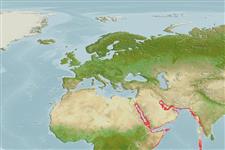Common names from other countries
Environment: milieu / climate zone / depth range / distribution range
Ecología
marino asociado a arrecife; rango de profundidad 0 - 18 m (Ref. 11441). Tropical
Western Indian Ocean: Arabian Peninsula from the northern Red Sea to the Persian Gulf.
Tamaño / Peso / Age
Maturity: Lm ? range ? - ? cm
Max length : 7.2 cm TL macho / no sexado; (Ref. 11441)
Short description
Claves de identificación | Morfología | Morfometría
Espinas dorsales (total) : 12; Radios blandos dorsales (total) : 10 - 12; Espinas anales: 2; Radios blandos anales: 11. Body olive brown, the scale edges darker, shading to gray ventrally. Margin of spinous portion of dorsal and anal fins and lateral edge of pelvic fins blue. The axil of the pectoral fins bright orange-yellow. Caudal fin light greenish gray with a broad black band in each lobe and a narrow blue upper and lower margin.
Adults form aggregations on reefs to feed on zooplankton. Take shelter in branching corals (Ref. 11411). Oviparous, distinct pairing during breeding (Ref. 205). Eggs are demersal and adhere to the substrate (Ref. 205). Males guard and aerate the eggs (Ref. 205)..
Life cycle and mating behavior
Maturities | Reproducción | Spawnings | Egg(s) | Fecundities | Larva
Oviparous, distinct pairing during breeding (Ref. 205). Eggs are demersal and adhere to the substrate (Ref. 205). Males guard and aerate the eggs (Ref. 205).
Randall, J.E., 1995. Coastal fishes of Oman. University of Hawaii Press, Honolulu, Hawaii. 439 p. (Ref. 11441)
IUCN Red List Status (Ref. 130435)
CITES (Ref. 128078)
Not Evaluated
Threat to humans
Harmless
Human uses
Herramientas
Special reports
Download XML
Fuentes de Internet
Estimates based on models
Preferred temperature (Ref.
115969): 26.1 - 29.2, mean 27.8 (based on 315 cells).
Phylogenetic diversity index (Ref.
82804): PD
50 = 0.5000 [Uniqueness, from 0.5 = low to 2.0 = high].
Bayesian length-weight: a=0.01778 (0.00796 - 0.03971), b=2.99 (2.81 - 3.17), in cm Total Length, based on LWR estimates for this Genus-body shape (Ref.
93245).
Nivel trófico (Ref.
69278): 3.4 ±0.45 se; based on food items.
Resiliencia (Ref.
120179): Alto, población duplicada en un tiempo mínimo inferior a 15 meses (Preliminary K or Fecundity.).
Fishing Vulnerability (Ref.
59153): Low vulnerability (10 of 100).
